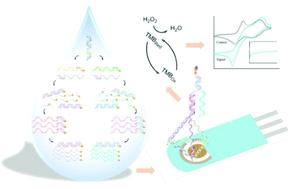Our official English website, www.x-mol.net, welcomes your
feedback! (Note: you will need to create a separate account there.)
A tetrahedral DNA nanostructure-decorated electrochemical platform for simple and ultrasensitive EGFR genotyping of plasma ctDNA.
Analyst ( IF 3.6 ) Pub Date : 2020-05-06 , DOI: 10.1039/d0an00591f Xuyao Wang 1 , Jianping Wu , Weilin Mao , Xia He , Liming Ruan , Junlan Zhu , Peng Shu , Zhenqi Zhang , Bitao Jiang , Xingguo Zhang
Analyst ( IF 3.6 ) Pub Date : 2020-05-06 , DOI: 10.1039/d0an00591f Xuyao Wang 1 , Jianping Wu , Weilin Mao , Xia He , Liming Ruan , Junlan Zhu , Peng Shu , Zhenqi Zhang , Bitao Jiang , Xingguo Zhang
Affiliation

|
Genotyping of the epidermal growth factor receptor (EGFR) mutation status is of great importance in the screening of appropriate patients with advanced non-small cell lung carcinoma (NSCLC) to receive superior tyrosine kinase inhibitor (TKIs) therapy. Yet conventional assays are generally costly with a relatively long turnaround time for obtaining results, which can lead to a bottleneck for immediately starting TKI therapy in late-staged patients. In this study, we propose an on-site electrochemical platform for sensitive simultaneous genotyping of the two major EGFR mutations (19del and L858R) through plasma ctDNA based on tetrahedral DNA nanostructure decorated screen-printed electrodes (SPE). Linear-after-the-exponential (LATE)-PCR combined with the amplification refractory mutation system (ARMS) was adopted to produce abundant biotin-labeled single-stranded DNA with high amplification efficiency and specificity. Disposable SPE decorated with self-assembled tetrahedral nanostructured DNA probes that showed ordered orientation and good target accessibility enabled the highly efficient hybridization of the specific amplicons through a sandwich-type and quantitatively translated the interfacial hybridization event into electrochemical signals via enzymatic amplification. Taking advantage of the ARMS-based LATE-PCR and the tetrahedral nanostructure-decorated SPE platform, we achieved the accurate detection of around 30 pg DNA of 19del or L858R, or as low as 0.1% of them in the presence of wild-type DNA. Moreover, the EGFR mutation profiles of 13 NSCLC patients we enlisted were accurately genotyped by our electrochemical platform, the results of which were in good agreement with those of commercial genetic detection methods.
中文翻译:

四面体DNA纳米结构修饰的电化学平台,用于血浆ctDNA的简单和超灵敏EGFR基因分型。
在筛选合适的晚期非小细胞肺癌(NSCLC)患者以接受更好的酪氨酸激酶抑制剂(TKIs)治疗的患者中,表皮生长因子受体(EGFR)突变状态的基因分型非常重要。然而,常规测定通常花费昂贵,并且需要相对较长的周转时间以获得结果,这可能导致在晚期患者中立即开始TKI治疗的瓶颈。在这项研究中,我们提出了一个现场电化学平台,用于通过基于四面体DNA纳米结构修饰的丝网印刷电极(SPE)的血浆ctDNA对两个主要EGFR突变(19del和L858R)进行敏感的同时基因分型。采用指数线性扩增(LATE)-PCR结合扩增难治性突变系统(ARMS),以高扩增效率和特异性产生丰富的生物素标记单链DNA。用自组装四面体纳米结构DNA探针修饰的一次性SPE,显示出有序的方向和良好的靶标可及性,可通过夹心型对特定扩增子进行高效杂交,并将界面杂交事件定量转化为电化学信号通过酶促扩增。利用基于ARMS的LATE-PCR和修饰了四面体纳米结构的SPE平台,我们可以准确检测到约30 pg 19del或L858R的DNA,或者在存在野生型DNA的情况下低至0.1% 。此外,我们所招募的13例NSCLC患者的EGFR突变谱已通过我们的电化学平台准确进行了基因分型,其结果与商业基因检测方法相吻合。
更新日期:2020-06-29
中文翻译:

四面体DNA纳米结构修饰的电化学平台,用于血浆ctDNA的简单和超灵敏EGFR基因分型。
在筛选合适的晚期非小细胞肺癌(NSCLC)患者以接受更好的酪氨酸激酶抑制剂(TKIs)治疗的患者中,表皮生长因子受体(EGFR)突变状态的基因分型非常重要。然而,常规测定通常花费昂贵,并且需要相对较长的周转时间以获得结果,这可能导致在晚期患者中立即开始TKI治疗的瓶颈。在这项研究中,我们提出了一个现场电化学平台,用于通过基于四面体DNA纳米结构修饰的丝网印刷电极(SPE)的血浆ctDNA对两个主要EGFR突变(19del和L858R)进行敏感的同时基因分型。采用指数线性扩增(LATE)-PCR结合扩增难治性突变系统(ARMS),以高扩增效率和特异性产生丰富的生物素标记单链DNA。用自组装四面体纳米结构DNA探针修饰的一次性SPE,显示出有序的方向和良好的靶标可及性,可通过夹心型对特定扩增子进行高效杂交,并将界面杂交事件定量转化为电化学信号通过酶促扩增。利用基于ARMS的LATE-PCR和修饰了四面体纳米结构的SPE平台,我们可以准确检测到约30 pg 19del或L858R的DNA,或者在存在野生型DNA的情况下低至0.1% 。此外,我们所招募的13例NSCLC患者的EGFR突变谱已通过我们的电化学平台准确进行了基因分型,其结果与商业基因检测方法相吻合。











































 京公网安备 11010802027423号
京公网安备 11010802027423号